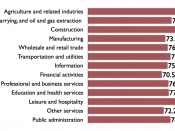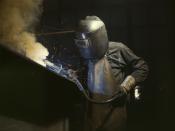The nature of white-collar work is varying over time through the changes at different levels and influenced by social changes. Any explanation of changes could merely reflect them to certain extent and contribute to only part of the facts.
White-collar work refers to 'employees who perform knowledge work, such as those in professional, managerial or administrative positions.' Comparing with blue -collar workers who act on materials, white-collar workers 'act with other people' (Haralambos, 2000, p701). Their work is much less physical than blue-collar worker whereas their performances are 'important for coordinating the activities of a company.'(Haralambos,2000, p701).
During the recent years, the world of work is increasingly a white-collar world. To begin with, numerical changes have taken places. Between 1900 and 2000, the percentage of the work force that is white collar grew from less than 18% to almost 60%. While manual workers comprised 41% of the work force in 1950, by the start of the twenty-first century, their proportion had shrunk to less than 25% of the work force.
This trend is expected to continue. In America, the number of professional workers such as technicians and related support workers is projected to increase in all major industrial sectors except mining sectors. In addition, 'executive, administrative, managerial, marketing, and sales occupations are expected to experience faster than average employment growth, further strengthening the dominant position of white collar work in the U.S. economy.'(Wilson. P, 2001, p13)
Moreover, the professional specialty occupations accounted for 14.1% of total employment in 1998. It is anticipated that their share of total employment will increase to 15.6% in 2008. This is the largest such increase projected for any occupational category. 'Two-thirds of the job growth is expected among teachers, librarians, and counselors; computer, mathematical and operations research occupations; and health assessment and treating occupations. These...



White collar workers,and class stratification
Not a bad paper. Good information and nice essay structure. Spelling and grammar need some work though.
0 out of 0 people found this comment useful.